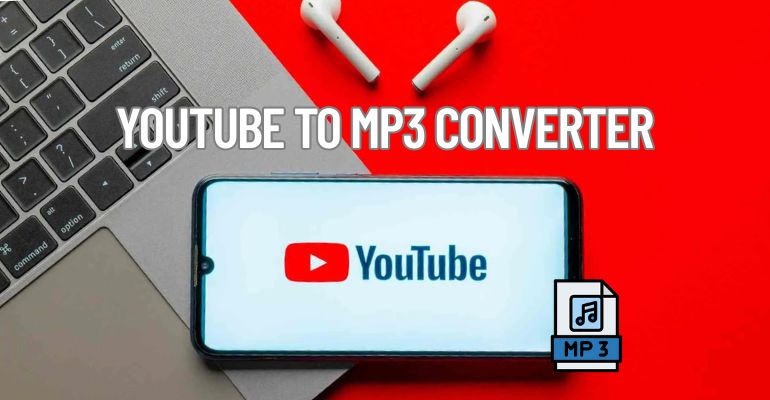Listening to your favourite YouTube videos offline has never been easier. Whether it’s a podcast episode on your commute, a playlist for your workout, or a lecture you want handy on your phone, converting YouTube videos to MP3 is now a quick and simple process. Modern converters give fast results, often needing just the video link and a click.
People use these tools every day for offline listening, playlist management, and creating audio collections to fit every mood. The best part? Most platforms let anyone turn a video into a high-quality MP3 in seconds, without long waits or complicated steps. Now, anyone can build their perfect audio library, no internet required.
How YouTube to MP3 Conversion Works
Turning a YouTube video into an MP3 is a two-step process: first, the audio is extracted from the video file, then it’s converted into the widely supported MP3 format. This process lets users save music, podcasts, or any other audio content for offline listening. There are multiple ways to convert YouTube videos to MP3, each catering to different needs—from quick online services to advanced desktop software and open-source solutions for tech users.
Online YouTube to MP3 Converters: Convenience and Speed
For most people, online converters are the fastest and most accessible way to grab MP3 audio. These web-based tools let users simply paste a YouTube link, choose their preferred audio quality, and download the result with just a few clicks. Some of the most popular platforms include YTMP3, Y2Mate, and EzMP3.
What makes online converters appealing?
- Ease of use: No software or account needed. Users just copy, paste, and go.
- Accessibility: These work in any browser and on any device, including phones and tablets.
- Instant results: Most sites finish the conversion within seconds for standard-length videos.
Things to keep in mind:
- Audio quality: Some converters offer choices up to 320kbps, but actual audio quality depends on the original video.
- Common limitations:
- Many limit video length (often to under 90 minutes per file).
- Batch downloads or full playlists may not be supported.
- Some sites have frequent pop-up ads or redirect links.
- Security tips: Stick to reputable sites, avoid suspicious pop-ups, and never enter personal information. Ad blockers help reduce unwanted interruptions.
For an ad-free and high-quality experience, EzMP3 lets users trim audio, pick different bitrates, and download without pop-ups, making it a great choice for quick conversions.
Desktop Software and Apps: Power, Quality, and Control
Users who convert many videos or care about audio fidelity often prefer desktop applications. Downloaded programs like Any Video Converter Free, 4K Video Downloader, and NoteBurner offer more features and flexibility.
Key features of desktop tools:
- High-bitrate audio: Get MP3s up to 320kbps, sometimes with even better quality compared to browser-based apps.
- Batch processing: Convert multiple videos or entire playlists in one go, saving loads of time.
- Playlist downloads: Grab all songs from a YouTube playlist with just a few clicks.
- Metadata handling: Some software auto-fills song titles, album names, and artwork.
Popular apps such as Any Video Converter Free deliver a reliable experience with support for a range of file formats, while tools like DVDVideoSoft’s YouTube to MP3 Converter are known for their simple interfaces and hi-fi output.
Desktop downloads use more system resources, but the added control makes them the top choice for users managing big collections or looking for the best possible quality.
Open Source and Command-Line Solutions
For those comfortable with tech and custom setups, open-source and command-line tools are a solid choice. Well-known options include youtube-dl (and its fork, yt-dlp) and ffmpeg. These don’t have fancy interfaces, but their flexibility and automation capabilities are unmatched.
How do they work?
These programs pull the video files directly from YouTube, extract the audio at the maximum available bitrate, and use encoders like ffmpeg to save the audio as MP3. Once installed, users run simple commands in the terminal to convert files, making the process fast and scriptable.
Benefits:
- Lossless quality: Maximizes the quality of the audio download, often surpassing web tools.
- Customization: Set exact output folders, file naming rules, and even automate the entire workflow with scripts.
- Large-scale automation: Perfect for users who want to convert hundreds of videos or schedule downloads.
For those looking to try open-source apps, resources like this GitHub project can help get started.
Open-source and command-line methods require some setup but pay off with top-notch results and endless flexibility. Bulk downloading, playlist management, and lossless output are all possible with just a bit of technical know-how.
Legal and Ethical Considerations
Turning YouTube videos into MP3s for personal use is common, but there are important legal boundaries everyone should know. Understanding copyright law, fair use, and YouTube’s policies makes the difference between safe, respectful use and risking legal trouble. This section guides readers on how to avoid pitfalls and respect creators’ work every step of the way.
Copyright Law, Fair Use, and Platform Policies
YouTube is filled with both original and copyrighted content. Not all videos are safe to download or convert. If someone shares content they didn’t make, or they use music, audio, or clips owned by others, copyright law may apply.
How can users tell what’s allowed?
- Personal, non-commercial use: Downloading or converting for individual listening, with no sharing or public use, is less likely to cause issues. This means keeping the MP3 on your device and not distributing it online.
- Fair use cases: Some laws allow short excerpts for commentary, education, or parody, but fair use is limited and can be unclear. Using whole songs or large portions for reasons outside teaching or review is high-risk. A simple rule: if you have to ask, it may not be fair use.
Users must consider both YouTube’s rules and the law. YouTube’s terms clearly say users should stream content through the website, not download it. Bypassing these terms by using third-party downloaders can be seen as breaking the agreement with the platform.
Key points for respecting creators and copyright:
- Don’t upload, share, or sell downloaded content.
- Always check a video’s licence; some creators use Creative Commons, which allows downloads, but most content is restricted.
- If in doubt, ask the creator for permission or look for royalty-free alternatives.
Learn more about fair use and creator rights at this informative breakdown.
Staying Safe and Avoiding Legal Risks
Beyond copyright, there are security, privacy, and policy risks. Many online converters and downloading platforms attract malware, ads, or phishing attempts. Using reputable tools reduces these dangers, but caution is still needed.
Follow these simple steps to lower risks:
- Pick trusted services: Stick to platforms mentioned in reliable guides or recommended by peers. Avoid any site that asks for personal data or login information.
- Respect platform rules: YouTube’s terms discourage downloading, especially with automated tools. Violating these terms can result in account bans or blocked access for repeat offences, as outlined in the YouTube terms of service.
- Data privacy: Pay attention to converter tools that ask for unnecessary permissions or try to install extra software. Some shady platforms may collect browsing data, so always use discretion.
- Regional laws: Some countries have stricter copyright rules and larger fines for infringement. Before downloading, check your local laws or consult resources like this full legal breakdown on YouTube converters.
- Use antivirus software: Protect devices from potential malware in free converter sites.
For a clear overview, check out additional guidance on whether converting YouTube videos is legal and safe in your region at TechLife Unity’s summary.
Keeping these guidelines in mind lets users enjoy offline MP3s without crossing the line legally or ethically. It’s all about smart choices and respect for everyone’s rights.
Best Practices for Instant, High-Quality YouTube to MP3 Conversions
Getting crisp MP3 audio from YouTube doesn’t have to be tricky or slow. The right choices make all the difference between a muddy, low-bitrate file and a sharp, enjoyable track you’ll want to listen to again. Quick conversions are possible, but never forget that security and quality should go hand in hand with speed. Here’s how users can make the most of any YouTube to MP3 conversion.
Tips to Maximize Speed, Quality, and Security
It’s tempting to grab the first converter found online, but a few simple tricks help users get the best results in seconds—without worry.
Choose the Right Bitrate
- For most music or podcasts, 192kbps hits a sweet spot of quality and small file size.
- If space isn’t an issue, 320kbps offers the highest clarity—perfect for audiophiles and home speakers.
- Lower bitrates like 128kbps shrink files for basic spoken word, but music will sound thin.
Sort Out Playlists Easily
- Batch conversion saves loads of time when a playlist has dozens of tracks.
- Some converters support whole playlist links, downloading all items in one go.
- For large playlists, check resources that allow multi-track downloads without slowing down.
Handle Metadata for Pro-Level Organization
- Good converters allow you to keep or edit song titles, artist info, and cover art.
- Clean metadata makes it much easier to find, sort and play songs on your device.
Stay Safe and Steer Clear of Malware
- Pick ad-free, reputable converters with clear privacy policies.
- Never download any installer or “required” software from a shady site.
- Use an ad blocker and an up-to-date antivirus for extra peace of mind.
Be Wary of Intrusive Ads and Tracking
- Stick with platforms that avoid pop-ups and won’t flood your browser with unwanted notifications.
- Working with a site praised for transparency means less risk of hidden tracking scripts.
For a first-person take on trusted experiences, users are chatting about safe converter options like CnvMP3 and other effective picks over on Reddit’s r/browsers.
Top Converter Recommendations for 2025
The right tool makes or breaks your YouTube to MP3 experience—these converters stand out this year for their speed, sound quality and reliable features, whether you want a free, ad-free web service or a robust desktop app with playlist support.
Best Free Online Converter:
- AudioCleaner: Fast, ad-free, and keeps consistent high-quality audio. Built-in AI noise reduction clears up harsh background sounds, while its smooth playlist function handles bulk downloads with very little user fuss. For those curious about its speed and usability, check out AudioCleaner’s YouTube to MP3 tool.
Most Versatile Desktop App:
- Any Video Converter Free: Handles single files and massive playlists alike, while maintaining crisp playback quality. It auto-fills tags and even supports lesser-known sites, not just YouTube. Its ease of use and flexibility explain why it’s regularly picked as the top YouTube to MP3 converter year after year.
Open-Source Powerhouse:
- YouTube-dl / yt-dlp and FFmpeg: Tech-savvy users who want to control every step opt for these. With simple scripts, you can queue up entire music collections, batch-edit tags and convert between formats. Popular with enthusiasts who enjoy custom setups, it’s praised as a highly reliable open-source solution.
Clean and Ad-Free Experience:
- CnvMP3: Highly recommended in communities for working without ads or unwanted software. It relies on donations instead of bombarding users with pop-ups, offering web-based or offline conversion that’s simple for anyone to use. Check one of its community reviews on Reddit.
Notable Trends for 2025:
- AI noise reduction is standard in top picks, giving every MP3 excellent clarity without background noise.
- Batch processing and playlist support help save time on big downloads.
- Communities continue to favour donation-supported tools that minimize advertising and junkware.
Reliable conversion no longer means trading speed for sound. With these best practices and tool picks, anyone can create a high-quality offline audio library instantly and securely, using simple settings and avoiding hidden risks.
Conclusion
Turning any YouTube video into an MP3 can be quick, smooth and safe when users pick the right tools and follow smart habits. The best experience strikes a balance: fast conversions, good audio quality, and respect for creators’ rights go hand in hand. Sticking with trusted sites or apps reduces risks, while following copyright rules keeps users out of trouble.
Choosing secure, ad-free platforms and setting audio quality to match their needs means listeners get the most out of every download. Anyone can enjoy an offline library without hassle, as long as they stay mindful of legal limits and support safe, reliable communities. By making careful choices and looking ahead, users keep audio downloads simple, legal, and enjoyable every time.
Thank you for reading. Feel free to share your own tips or favourite tools in the comments.














